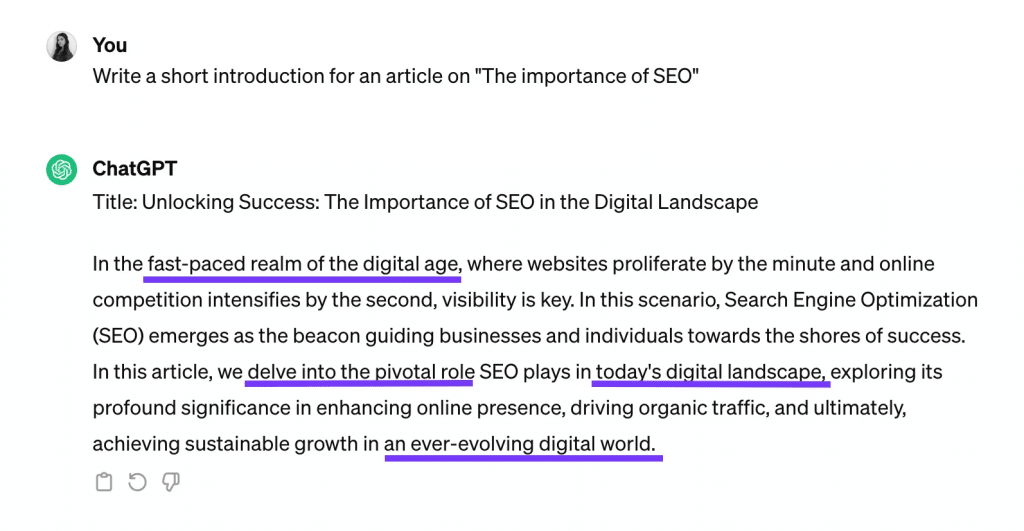In assisting brands with online communication, I’ve faced a significant challenge: making artificial intelligence (AI)-generated content feel authentic and human. Those who utilize AI technologies to write and create must ensure that these tools produce content that connects with people. The phrase “humanizing AI content” refers to more than simply a technical chore; it is a critical strategy that can transform how you reach and engage with your audience. Let’s look at how we can humanize AI content to feel as authentic and engaging as if it were authored by a human, altering how you interact with your audience.
What is an AI-generated Content?
AI-generated content includes text, photos, videos, and other media content produced by artificial intelligence algorithms.
These algorithms use Natural Language Processing (NLP) and Machine Learning (ML) technology to create fresh content that resembles human-like output.
Nowadays, AI content is widely used by enterprises, with 85.1% of AI users using the technology to write articles.
As a result, AI tools are frequently attributed as writers or contributors to blog posts.
Untapped Potential for AI in Content Creation
While the widespread use of AI tools in content creation speaks volumes about their effectiveness, there is a lesser-known story: how do these tools perform in terms of emotional connection? According to a Capgemini Research Institute survey, although 74% of customers are aware that they interact with AI-driven systems, a large majority perceive a lack of personalization. The fundamental issue resides in the gap between efficiency and empathy.
Key Takeaways
- AI-generated content should be enhanced with a human element to attract visitors while adhering to search engine criteria.
- Google’s E-E-A-T recommendations offer a useful framework for giving AI content a more human touch.
- Personalizing AI prompts, giving personal insights, and employing first-person pronouns can all considerably improve the human touch in AI content.
- Editing AI-generated content to include real-world examples, authoritative sources, and active voice improves its authenticity and believability.
- Regular fact-checking and rewriting of overused terms in AI content can help to avoid detection by AI detectors while also maintaining a natural flow.
Why Should You Humanize an AI Content?
Despite breakthroughs in AI, human monitoring is required to assure the quality, accuracy, and relevancy of AI-generated content.
Humanizing AI content is also critical for avoiding detection by search engines and AI detection technologies, especially given Google’s crackdown on the use of AI for content manipulation. This is one of the key themes in Google’s most recent core upgrade.
The problem is that AI-generated content frequently lacks a human touch, resulting in a narrative that appears bland and lacking in personality.
Here is a brief blog post introduction I requested ChatGPT to write:

As you can see, it begins with the dreaded “in the fast-paced realm of the digital age” and contains numerous overused AI terms such as “delve into”, “today’s digital landscape”, and “in an ever-evolving digital world”.
I suppose you’ve read similar introductions dozens of times. It feels stretched out, lacks originality, and loses readers’ attention.
Although Google has nothing against AI-written language, it will punish websites that use AI content to manipulate search engine algorithms or provide little to no value to readers.
AI algorithms are basically confined to the data on which they were taught, therefore they cannot generate truly original ideas or innovative thoughts that have not before been expressed.
They are unable to draw on personal experiences or make intuitive leaps, both of which are common characteristics of human creativity.
By incorporating a human touch into AI-generated writing, you can preserve authenticity and deliver value to your readers, which is consistent with Google’s emphasis on valuable content.
As Google says:
Regardless of how content is created, individuals who want to succeed in Google Search should strive to provide original, high-quality, people-first content that demonstrates E-E-A-T.
How to Humanize AI Content in 11 Steps
Here are eleven practical ideas on how to humanize AI-generated material into content that appeals to both readers and search engines.
#1. Personalize your prompt
If you want better results from AI content tools, you must offer them better instructions. The quality of the output is primarily determined by the quality of the input.
Use precise cues and supply the AI with detailed bespoke knowledge by asking it to:
- Adopt a persona
- Use a particular tone of voice.
- Provide detailed facts and examples.
- Exclude particular terms and phrases.
- Maintain a predetermined word count.
Finding the right prompt may take a few tries, which can be time-consuming.
Personalized instructions enable AI to generate content that reflects a greater understanding of specific themes, resulting in more nuanced outputs.
#2. Share your personal insights
People love tales, and so does Google. You can include anecdotes of success, failure, or learning events related to the topic in your content.
It’s an effective technique to distinguish your content in a sea of AI-generated pieces. Sharing a personal tale might be far more effective than generic guidance.
You can also give your personal perspectives on current industry trends, including how they may evolve and their possible impact.
This is an excellent technique to demonstrate your competence in the eyes of search engines. Google’s E-E-A-T guidelines emphasize the necessity of proving expertise in content production.
#3. Use an AI-humanized
An AI humanizer, also known as an anti-AI detector tool, analyzes text for common AI writing patterns—such as repetitious wording, misuse of specific terms, or an unnatural flow—and then recommends adjustments to make the content read as if authored by a person.
By using these tools, you can:
- Adjust tone and style to more closely resemble human writing.
- Replace excessive technical jargon with colloquial language.
- Change the sentence structure to approximate the pace and cadence of genuine speech.
- Introduce colloquialisms or idiomatic terms that AI may not normally employ.
You can utilize any AI writer, including ChatGPT, to generate humanized AI content.
You may then improve the AI-generated content to sound more natural and human-like.
However, make sure your content is useful to readers and not simply the outcome of mass AI content development.
Using an AI humanizer can help you save time throughout the editing process while also ensuring that your content remains interesting and relatable, as readers expect from human authors.
#4. Communicate authority
Another technique to humanize AI literature is to use relevant facts or case studies to back up your claims.
Let us look at an example from Optinmonster. The post uses real-life examples to demonstrate the effectiveness of guest posting and to assist visitors in grasping the benefits of the technique.

Rather than simply stating, “Guest posting is an effective marketing strategy,” the sentence “Buffer used guest posting to attract 100,000 customers” and linking to the case study gives the content a lot more weight and credibility.
Simply put your phrase in Google, followed by “statistics” or “case studies,” and you’re done.
[Keyword] Statistics.
[Keyword: Case Studies]
Alternatively, you can instruct AI to seamlessly incorporate such references into the content. Just remember to always cite your sources in the end.
#5. Provide real-life instances
Integrating photographs, self-created charts, infographics, and videos enhances your content and gives persuasive proof to back up your argument.
These visual features can turn abstract ideas into real instances, making the message more understandable and remembered.
For example, Brand24 employs real-life examples to demonstrate the significance of advertising in appealing to the audience’s emotions.

And, as you might expect, I’m using real-life examples throughout this piece to explain and reinforce our point.
Furthermore, no one likes reading long blocks of text; visual components help break up monotony and create a more engaging reading experience.
Also, examples demonstrate the author’s direct involvement and practical expertise of the subject, successfully highlighting the ‘Experience’ component of Google’s E-E-A-T standards.
Take a look at Landingi’s piece, which explains how to set up Google Analytics 4 (GA4) accounts to measure micro-conversions.
In contrast to a text-only step-by-step approach, the graphics provide users with practical information on what they need to do and how to do it, demonstrating that the author has firsthand knowledge of the subject.
#6. Use first-person pronouns.
Since 2023, Google has prioritized ‘Experience’ as part of its E-E-A-T principles, emphasizing the importance of content provided from direct, personal encounters or hands-on knowledge in a specific sector.
Along with personal thoughts and examples, utilizing first-person pronouns allows you to demonstrate firsthand experience with the subject.
Zippy’s case study discovered that content featuring first-person pronouns such as “I,” “my,” “we,” and “ours” frequently rank higher in search results.
Here’s how Pack Hacker uses first-person pronouns and visuals to demonstrate that their reviews are based on actual experience.

First-person pronouns can also serve as social proof for readers, reminding them that the content is written by expert humans.
#7. Rewrite overused words and phrases
As I have stated, AI-generated content tends to repeat itself.
There are many terms that AI tools, such as ChatGPT, enjoy using—and they are a dead giveaway to AI detectors.
You must identify and rewrite them to make your AI-generated text sound more human.
Here’s a small list of words and phrases to look out for:
- “In today’s world,” “In the world of,” “In today’s era”
- “Unlock,” “unleash,” “unveil,” “unravel,” “uncover”
- “Critical,” “crucial,” “essential,” “it’s important to”
- “Delve,” “embark on a journey,” “pave the way”
- “In conclusion,” “in summary,” “ultimately”
- “Furthermore,” “moreover,” “additionally”
- “Bustling,” “vibrant,” “hustle and bustle”
There is also a Reddit thread about this exact topic.
As a general rule of thumb, watch for pretentious adjectives that sound like they came from someone attempting to demonstrate his “intricate” vocabulary—there’s no need for that.
You can also run your AI-created text via an AI detector such as Originality. Although not always accurate, most AI detectors identify sentences that are likely to have been generated by AI, giving you a better indication of what you should rework.
#8. Use the active voice
The content of AI text is generally written in passive voice, making it far more difficult to read.
Here is a simple example:
Passive: “The content was written by him.”
“He wrote the content.”
The second phrase is more simple, fluff-free, and appealing.
Rewrite the content in an active voice to make it sound more genuine. Alternatively, you can utilize an AI program such as Surfy to perform it for you.
Simply highlight the text and ask Surfy to rewrite it in active voice.
#9. Fact-check AI content
AI content is not always reliable, and misrepresentation produced by AI-generated writing is not uncommon.
The online world is full of stories like this one.
This is because AI tools do not understand the context and meaning of prompts in the same way that human authors do—they regard them as mere strings of words.
They respond to your orders by studying your cues and selecting terms that are statistically more likely to contain the solution.
This method can result in mistakes, thus it is critical to fact-check AI content against trustworthy sources and offer citations to ensure accuracy and consistency.
This increases the trustworthiness and depth of your content, demonstrating to readers that you have done your research.
#10. Edit like an actual human
If there’s one thing I’ve emphasized throughout this essay, it’s that you should approach AI-generated content as a rough draft rather than a finished blog post. So, do not skip the editing phase.
Edit the content to reflect your brand’s voice and add personal thoughts and examples to ensure the end product is engaging and authentic rather than generic and automated.
To make AI writing feel more natural, change the length of sentences and paragraphs to reflect the ebb and flow of human communication.
Furthermore, replace jargon or uncommon phrases with simpler, everyday language that readers are more likely to use and comprehend.
As a result, you can gain the trust of your readers while also lowering your chances of being detected by AI.
Let’s look at a practical case. Here’s a quick blog introduction I made with ChatGPT:
This is how I would alter it:
“Fun fact: Google’s name is a misspelling of the word ‘googol,’ a mathematical term for a 1 followed by 100 zeros, which hints at the search engine’s endless resources of information. But there are a lot more to the story of Google! Let’s have a look at the tech giant’s history and see how a small garage project turned into a company that now rules the internet.”
The introduction is now more straightforward and conversational, although it still contains many of the concepts created by the chatbot.
#11. Choose the appropriate AI content tool
Using an AI tool to write human-like content ensures that the result is engaging and does not trigger AI content detectors.
When selecting the best AI content generation tool, you should consider numerous things, including your content’s unique requirements, the level of customization required, and the tool’s content production efficiency.
Let’s look at each of these aspects.
1. Content requirements
Are you looking to create ordinary content, or are you striving for SEO-optimized copy that performs well in search engine rankings and attracts visitors to your website?
While technologies like ChatGPT excel in producing cohesive text, they lack built-in SEO features, which are critical for content optimization.
In contrast, AI solutions such as Surfer AI include capabilities expressly meant to improve SEO, such as keyword research and content structure optimization, to ensure that the content not only reads well but also performs well in search engine rankings.
2. Customization options
The quality of the AI-generated output is dependent on the quality of the input. So it’s critical to select a tool that allows you to personalize the input.
Prompt-based tools provide nearly limitless customizing opportunities. It’s simply a matter of selecting the appropriate prompt and personalizing it for each request.
However, endless possibilities in the absence of structure are not always desirable. They can be hit or miss.
3. Efficiency
The fundamental goal of AI writing tools is to streamline the content generation process, hence increasing efficiency and productivity for writers and businesses alike.
While prompt-based AI solutions can be effective, they frequently require extensive trial and error to fine-tune the prompts and obtain the intended results. This back-and-forth can be time-consuming, perhaps counteracting the efficiency improvements they are intended to deliver.
Can Search Engines and Readers Distinguish Between AI and Humanized Content?
Both search engines and readers can distinguish between AI and human-written content.
While Google has stated that it does not necessarily disapprove of AI-generated content, using it purely to manipulate search engine algorithms would result in penalties.
Remember that Google values actionable, value-packed content; merely churning out AI-generated content to increase volume will not impress them.
Meanwhile, readers are already accustomed to the dismal and uninteresting language associated with AI content generators.
That’s why, AI content without a human touch is likely to drive people away, harming your SEO efforts and brand.
Some Things to Remember When Working With AI
Using AI to create content is not flawless, therefore remember these guidelines to avoid frequent pitfalls:
- Consider AI as a “co-writer”: Treat AI as a collaborator rather than a substitute for human creativity and critical thinking. It can help and improve your writing, but it isn’t a perfect substitute.
- Consider it a first draft: You’ll need to edit, alter, and personalize AI-generated content to make it truly yours.
- Fact-check your content: To avoid incorrect or obsolete data, always verify the accuracy of AI-provided material.
- Check the recency of information: AI models are trained on data from a certain date, therefore double-check your work against current information.
- Avoid algorithmic bias: It’s important to consider training data and available information. Read any AI-generated writing critically, taking into account cultural, social, environmental, and political subtleties that are pertinent to you and your issue. Keep in mind that different points of view are also important.
- AI does not add anything new: Because AI draws information from current sources, it does not contribute any fresh insights or views to the discussion. This is where human writing in AI-generated content can shine, bringing unique viewpoints and sparking intriguing interactions.
Conclusion
To humanize AI content entails not only developing technology but also rethinking our connection to it. It is about ensuring that when machines learn to speak, they do so with unmistakable human warmth and compassion. How will you rethink your strategy to ensure that your AI-generated content does more than just talk to your audience; it also connects with them
What steps will you take today to humanize your AI content strategy?
Related Articles
- Gated Content: The Secret to Getting More Leads
- Content Team: How to Build & Grow an Effective Content Team
- Content Development Best Practices for Higher Engagement
- What Is Creative Content? All You Need 2024
- I Doubled My Traffic Overnight By Using This Curated Content Hack






